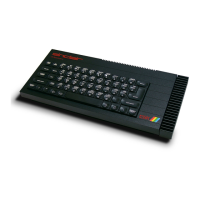Sinclair ZX Spectrum Service Manual
Spectrum For Everyone https://spectrumforeveryone.com/
12
The RGB colour, bright-up and composite sync signals (Figure 1.6) are coupled to the RGB output socket
via 68-ohm resistors and are suitable for direct input to a wide range of colour monitors. The same
signals are also applied to the encoder IC36 to produce a composite video output at pin 6. The video
circuit comprises of the following components:
a) Line/frame sync with colour burst, derived from the composite sync input CS and a burst
oscillator sustained by tank circuit L3. The position of the burst relative to the line sync pulse is
determined by a threshold level set-up on the RAMP input of IC36 by R113/C115.
b) Colour chrominance is derived by modulating the chroma sub-carriers with the colour difference
signals decoded from the RGB and bright-up signals. The latter are first combined using a diode
matrix D20-D25 to produce six colour inputs for IC36 - two for each colour, designated ‘0’ and
‘1’. Without bright-up the presence of any digital colour input at logic ‘1’ drives the ‘1’ input
only, producing a pixel display with the colour intensity set for normal viewing. With bright-up
activated the ‘0’ and ‘1’ inputs are driven, increasing the intensity so as to highlight the pixel
display.
c) Luminance (grey scale) derived by mixing the RGB inputs in a fixed proportion. The signal is used
to produce the colour difference signals in (b) and in its own right to drive the black and white
monitor. The luminance is brought out at IC36 pin 7 and is applied to the RGB output socket via
a complimentary transistor pair TR13,14.
The luminance is returned to IC36 mixed with the FM modulated sound carrier from IC38. The
sound modulator operates at 6 MHz in the UK (5.5 MHz in most other European countries) and
is tuned by L4. The modulating signal is derived either by the ULA sourced via R112/C123 or the
sound generator circuit IC32 via R132/C127.
The composite video signal at IC36 pin 6 is finally applied to an encapsulated UHF modulator operating
on European standard channel 36. The device is current driven via TR10,11,12 to give improved linearity
thus reducing the effect of sound on vision and vice-versa. The effect is further reduced by outputting
the sound carrier 20dB down with respect to the picture carrier.
1.5.2 Keyboard Scanning
Every 20ms (i.e. once per maskable interrupt), the CPU systematically scans the keyboard recording
which keys (if any) have been depressed. The scanning method is described below with the aid of
Figures 1.3 and 1.4, As the figures clearly illustrate the main keyboard consists of an upper and lower
membrane. The upper membrane is organised as an 8 x 5 matrix, the intersection of each row and
column bridged by a normally open switch contact. The lower membrane is organised in a similar
manner except that only 16 of the intersections are populated by switch contacts. The row 'outputs' and
column 'inputs' are shown connected in both cases to separate ribbon cables KB1 and KB2, one to the
ULA and the other to the high order address lines A15-A8. Pull-up resistors R65 through R69 ensure that
when the address bus is in the high Z state, or none of the switch contacts is closed, row outputs KB1-
KB4 remain high.

